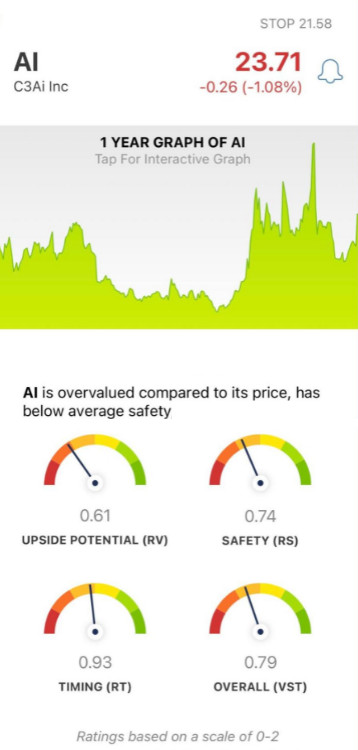20 Recommended Suggestions For Deciding On Ai Chart Analysis Sites
20 Recommended Suggestions For Deciding On Ai Chart Analysis Sites
Blog Article
Top 10 Tips To Evaluate The Market Coverage Provided By Ai-Powered Stock Predicting/Analyzing Platforms
Market coverage is one of the most important factors to take into consideration when looking at AI-powered trading platforms. It determines the number of assets and markets are accessible. A platform that offers comprehensive market coverage will allow investors to diversify their portfolios and discover global trading opportunities and adapt to various strategies. Here are 10 best tips to help you evaluate the market coverage provided by these platforms.
1. Evaluate Supported Asset Classes
Stocks: Ensure that the platform includes stocks from the top stock exchanges, which include NYSE, NASDAQ and LSE.
ETFs Make sure the platform allows you to select from a wide range of ETFs. This can provide you with a variety of exposure.
Options and futures: Verify whether the platform supports derivatives, such as futures, options and other leveraged instruments.
Commodities and Forex. Determine whether the platform offers forex pairs, precious and base metals, energy-related products, and agricultural products.
Cryptocurrencies: Make sure the platform supports major cryptocurrencies (e.g., Bitcoin, Ethereum) and altcoins.
2. Verify coverage in your area
Global markets - Ensure that the platform has the capacity to serve all major markets across the globe including North America (including copyright), Europe, Asia-Pacific markets and emerging ones.
Regional focus: Check if your platform has a distinct market or market that is compatible with your trading requirements.
Local exchanges: Find out if the platform supports regional or local exchanges that relate to your area or your strategy.
3. Compare real-time data with delayed Data Delayed Data
Real-time data is essential for quick decision making, particularly in active trading.
Data that is delayed - Determine if delayed data is free or is available at a reduced cost. This might be enough for investors who are looking to invest over the long-term.
Data latency: Check whether the platform reduces latency for data, particularly in high-frequency trading.
4. Review historical data availability
The depth of the historical data: Ensure the platform offers vast historical data (e.g. 10, more than 10 years) for backtesting and analysis.
Granularity: Check if historical data contains daily, intraday weekly, monthly, and daily level of granularity.
Corporate actions - Examine previous data to confirm that it reflects stock splits or dividends, as well as other corporate activities.
5. Check for market depth and order information
Data Level 2: Ensure the platform offers Level 2 (order book depth), for better price discovery.
Check the bid-ask ranges to make sure you are getting the most accurate price.
Volume data: Verify if the platform includes specific volume data to analyze market and liquidity.
6. Assess Coverage of Indices and Sectors
Major indices: Ensure that your platform can support major indices like the S&P 500 (e.g. NASDAQ 100 or FTSE 100), for benchmarking based on indexes.
Sector-specific data: Check whether the platform has information for certain sectors (e.g., technology, healthcare, energy) to conduct a targeted analysis.
Custom indexes: Check if the platform allows creating or tracking custom indices based on your requirements.
7. Integrate Sentiment and News Data
News feeds: Ensure that the platform integrates real-time news feeds from reputable sources (e.g., Bloomberg, Reuters) for events that affect the market.
Sentiment analysis Find out if your platform has sentiment analysis tools that use social media data, news sources, or any other sources of data.
Event-driven strategy: Verify that the platform is compatible with events-driven trading strategies (e.g. announcements of earnings economic reports, announcements of earnings).
8. Verify Multi-Market Trading Capability
Cross-market trading: Make sure that the platform supports trading across markets and asset categories through a single interface.
Currency conversion Check to see whether you can convert currencies automatically for international trades and if there are accounts that support multi-currency transactions.
Time zone support: Find out whether the trading platform you are using can be used in different time zones for markets across the globe.
9. Examine the coverage of alternative sources
Alternative data: For unique insights, check that your platform utilizes other data sources (e.g. satellite imagery web traffic, satellite imagery, or credit card transactions).
ESG data - Verify that the platform offers environmental, social, and governance information (ESG). This is important for an investment that is socially conscious.
Macroeconomics data: For basic analysis, ensure that the platform is stocked with macroeconomic indicators such as GDP (gross domestic product) inflation rates, GDP and interest rates.
Review Customer Feedback and Market Reputation
User reviews: Look for feedback from users to gain a better understanding of the platform.
Industry reputation: Verify whether the platform is acknowledged by experts in the industry for its market coverage.
Testimonials and case studies These will demonstrate the performance of the platform in particular markets or classes of assets.
Bonus Tips
Trial time: You can try an demo, trial or free trial to evaluate the coverage of markets as well as the quality of data.
API access: Verify that your platform's API can access market data in a programmatic manner to run custom analyses.
Customer Support: Verify that the platform is able assist with any market-related issues or data issues.
These guidelines will assist you to assess the market coverage offered by AI trading platforms that forecast or analyze the prices of stocks. In this way, you'll be able select the one that provides you with the data and markets you need for successful trading. You can diversify your portfolio and take advantage of new opportunities using a broad market coverage. View the top full article on incite ai for site recommendations including ai trading, ai options trading, ai chart analysis, ai investment app, using ai to trade stocks, best ai stock, ai stock picks, best stock advisor, ai trade, ai for trading and more.
Top 10 Ways To Evaluate The Risk Management Of Ai-Based Stock Trading Platforms
Risk management plays a vital function in any AI-powered stock trading platform. It safeguards your investment by limiting losses that could occur and enables you to maximize profits. Platforms with robust risk-management tools will help you navigate uncertain markets and make educated decisions. Here are ten top tips to help you assess the risk management abilities of these platforms.
1. Study Stop-Loss Features and Take Profit Features
Levels that can be customized - Make sure that the platform lets you customize your stop-loss, take-profit and profit level for every trade or strategy.
Check to see if your trading platform supports trailing stop, which adjusts automatically when the market shifts towards your.
Guaranteed stops: Check whether the broker offers guarantees on stop-loss orders that assure that your trade is completed at the specified price, even in volatile markets.
2. Utilize Position Sizing Tools
Fixed amount - Ensure that you can define the size of your positions relative to a specific amount.
Percentage: See whether you can define your position sizes as proportion to the value of your portfolio. This will enable you to manage risk proportionally.
Risk-reward: Check if your platform allows you to set risk-reward for each strategy or trade.
3. Make sure you are using Diversification Aid
Multi-asset trading. Make sure that your platform supports different asset classes like ETFs and Forex, Options, and Stocks.
Sector allocation: Determine whether your platform offers tools to manage and monitor the exposure to sectors.
Geographic diversification: Verify if the platform supports trading in international markets to spread the geographic risk.
4. Examine the Margin and Leverage Controls
Margin requirements: Ensure the platform is clear about margin requirements when trading leveraged.
Examine whether you can establish limit on leverage to limit risk exposure.
Margin calls: Ensure that you receive timely notifications from the platform to avoid account liquidation.
5. Assessment and reporting of risk
Risk metrics: Ensure that the platform offers key risk indicators (e.g. Value at Risk (VaR) Sharpe ratio drawdown) to your portfolio.
Evaluation of scenarios: Ensure that the platform you're using allows you to simulate market scenarios and analyze risk.
Performance reports: Determine if you can get detailed performance reports through the platform, including risk-adjusted results.
6. Check for Real-Time Risk Monitoring
Monitoring of your portfolio: Make sure your platform permits you to track your portfolio in real-time.
Alerts and notifications: Check the platform's ability to provide real-time alerts for events that may be risky (e.g. breached margins or stop loss triggers).
Risk dashboards: Make sure the platform provides an adjustable risk dashboard that gives you an entire picture of your personal profile.
7. Assess the effects of stress testing and backtesting
Stress testing: Ensure that the platform you use allows you to test your portfolio or strategies in extreme market conditions.
Backtesting - Check to see the platform you use allows you to backtest strategies with old data. This is a fantastic method to gauge the risk and evaluate the performance.
Monte Carlo simulators: Verify that the software is using Monte Carlo to simulate a number of possible outcomes in order for you to evaluate risks.
8. Risk Management Regulations - Assess the Compliance
Check for regulatory compliance: Make sure that the platform is compliant with applicable risk-management regulations (e.g. MiFID II, Reg T, in the U.S.).
Best execution: Ensure that the platform adheres with the best execution practices. Trades will be executed at the lowest cost feasible to limit loss.
Transparency: Check to see whether the platform is able to disclose risks in a clear, transparent way.
9. Examine the parameters of risk that are user-controlled.
Custom risk rules: Ensure the platform permits you to create custom risk management guidelines (e.g. the maximum daily loss, or maximum position size).
Automated risk controls Check to see whether your platform is able to enforce risk management rules based upon the parameters you've defined.
Manual overrides: Make sure to check whether the platform permits manual overrides of automated risk controls in the event of emergency.
Review of User Feedback and Case Studies
User feedback: Use user reviews to evaluate the platform's ability to manage the risk.
Case studies: Look for case studies or testimonials highlighting the capabilities of the platform for managing risk.
Community forums: Check whether the platform hosts an active community of users where traders share risk management tips and strategies.
Bonus Tips:
Free Trial: Try out the platform's features to manage risk in real situations.
Customer support: Ensure you have a reliable support system regarding risk management related issues or questions.
Educational resources: Determine whether you can find any educational materials available on the best practices for managing risk.
If you follow these guidelines and techniques, you will be able to assess the risks management capabilities of AI trading platforms that predict or analyze stocks Be sure to select the one that can safeguard your investment and reduce potential losses. The use of robust risk management tools is essential for navigating turbulent markets and achieving trading success. Have a look at the best advice on ai stock picker for blog info including ai trading software, copyright ai trading bot, ai for investing, ai stock price prediction, chatgpt copyright, chart ai trading, ai trading app, investing ai, ai investment platform, stock analysis websites and more.